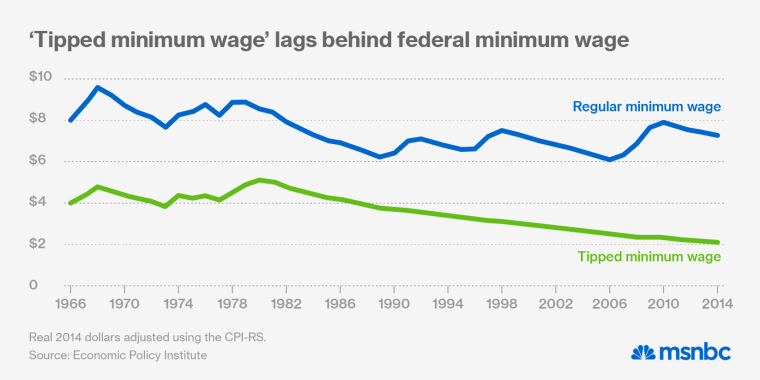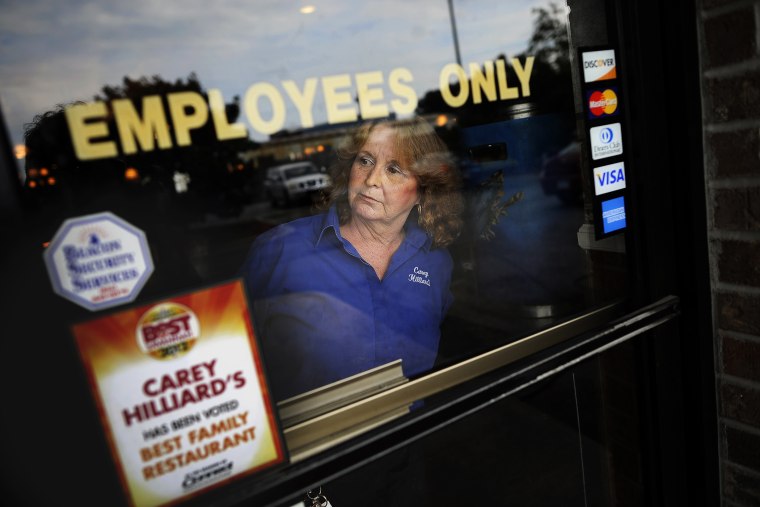Cities and states across the country are hiking their minimum wages absent any efforts by Congress to do so at the federal level. While that's good news for many low-wage workers, waiters and others partly compensated in tips aren't necessarily reaping the benefits.
Restaurant industry groups like the National Restaurant Association (NRA) argue that the average tipped worker makes a decent living, but a new study from the Economic Policy Institute (EPI) says otherwise. EPI, which is partially funded by organized labor, found that the median tipped wage is significantly lower than the overall median wage—about $10.22 per hour versus $16.48. What's more, the study found, tipped workers "experience poverty at much higher rates than the overall workforce." The poverty rate for tipped workers was found to be 12.8%, versus 6.5% for other workers.
Chicago, which could soon raise its base minimum wage from $8.25 to $13 per hour, is proposing a much smaller increase to the tipped minimum wage. If the recommendation from the city's minimum wage task force goes through, tipped employees would get just $1 added to their current base wage of $4.95 per hour.
All but seven states in the country have a tipped wage that's different from the regular minimum wage. Under federal law, the tipped minimum wage is $2.13, with a $5.12 "tip credit" for employers; in other words, tipped workers are still expected to make at least $7.25 per hour (the regular minimum wage on the federal level), but management is allowed to pay less if the customers tip more.
The poverty gap between tipped and nontipped workers may have been exacerbated by the gap between the tipped minimum wage and the regular minimum wage, which is now at a record high.
In 1966, the tipped wage was 50% of the regular minimum wage. By 2014, it was just 29% of the minimum wage. Although employers are expected to cover the gap between the tipped wage and the regular minimum wage when tips are insufficient, a recent White House report [PDF] noted that "tipped workers are at greater risk of not earning the full minimum wage," in part because of "the challenges of ensuring compliance with minimum wage laws for tipped workers."
In other words, employers are more likely to get away with not paying minimum wage if they can claim that tips make up the difference—regardless of whether or not they actually do. And women are disproportionately likely to suffer the consequences.

"The biggest occupation for tipped workers is food services, and most of those are women," said Sylvia Allegretto, an economist at UC Berkeley's Institute for Research on Labor and Employment, and one of the authors of the report. "About 67% of tipped workers are women, and almost 69% when you look at just waiters and bartenders are women, so this is disproportionately a women's issue for sure."
Congress actually excluded tipped workers, along with domestic workers and agricultural workers, from the Fair Labor Standards Act when it was passed in 1938. It was only in 1966 that the law was expanded to include tipped employees, through the introduction of the 50% "tip credit," a literal half-measure to bring tipped employees closer to a standardized wage.
Yet even when the base minimum wage goes up, the restaurant industry has been remarkably successful at keeping the tipped minimum wage frozen or nearly so. Up until eighteen years ago, federal law mandated that the base tipped wage never go below 50% of the federal minimum wage, and in 1990 it actually reached a high of 60%. That all changed under President Clinton, who in 1996 signed a law decoupling the tipped wage from the regular minimum wage.
He do so "under, from what I could tell, massive pressure from the restaurant industry, which was headed up by (2012 Republican presidential contender) Herman Cain at the time," said Allegretto.
The industry has continued its campaign against wage hikes to this day. The day before the EPI study came out, the conservative lobbying group the Employment Policies Institute took out an ad [PDF] in the Washington Post suggesting that a proposed hike in the tipped wage "will dramatically reduce employment in the restaurant industry."
Allegretto isn't convinced. For empirical evidence, she pointed to states like California and Washington which don't have a tip credit.
"Our minimum wage in California is $9 an hour," she said. "In Washington, it's $10 an hour. And in these states, like across the U.S., the restaurant industry is booming."
CLARIFICATION: This story has been updated to note that the Economic Policy Institute receives much of its funding from organized labor.
